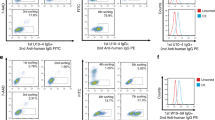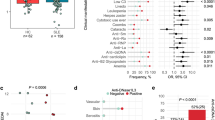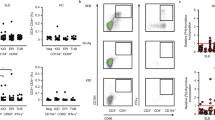Abstract
It remains unclear how and why autoimmunity occurs. Here we show evidence for a previously unrecognized and possibly general mechanism of autoimmunity. This new finding was discovered serendipitously using material from patients with inflammatory vascular disease caused by antineutrophil cytoplasmic autoantibodies (ANCA) with specificity for proteinase-3 (PR-3). Such patients harbor not only antibodies to the autoantigen (PR-3), but also antibodies to a peptide translated from the antisense DNA strand of PR-3 (complementary PR-3, cPR-3) or to a mimic of this peptide. Immunization of mice with the middle region of cPR-3 resulted in production of antibodies not only to cPR-3, but also to the immunogen's sense peptide counterpart, PR-3. Both human and mouse antibodies to PR-3 and cPR-3 bound to each other, indicating idiotypic relationships. These findings indicate that autoimmunity can be initiated through an immune response against a peptide that is antisense or complementary to the autoantigen, which then induces anti-idiotypic antibodies (autoantibodies) that cross-react with the autoantigen.
This is a preview of subscription content, access via your institution
Access options
Subscribe to this journal
Receive 12 print issues and online access
$209.00 per year
only $17.42 per issue
Buy this article
- Purchase on Springer Link
- Instant access to full article PDF
Prices may be subject to local taxes which are calculated during checkout






Similar content being viewed by others
Accession codes
References
Jacobson, D.L., Gange, S.J., Rose, N.R. & Graham, N.M. Epidemiology and estimated population burden of selected autoimmune diseases in the United States. Clin. Immunol. Immunopathol. 84, 223–243 (1997).
Xiao, H. et al. Antineutrophil cytoplasmic autoantibodies specific for myeloperoxidase cause glomerulonephritis and vasculitis in mice. J. Clin. Invest. 110, 955–963 (2002).
Hellmark, T., Burkhardt, H. & Wieslander, J. Goodpasture disease. Characterization of a single conformational epitope as the target of pathogenic autoantibodies. J. Biol. Chem. 274, 25862–25868 (1999).
Dau, P.C. et al. Plasmapheresis and immunosuppressive drug therapy in myasthenia gravis. N. Engl. J. Med. 297, 1134–1140 (1977).
Weetman, A.P. & McGregor, A.M. Autoimmune thyroid disease: further developments in our understanding. Endocr. Rev. 15, 788–830 (1994).
Stassi, G. & De Maria, R. Autoimmune thyroid disease: new models of cell death in autoimmunity. Nat. Rev. Immunol. 2, 195–204 (2002).
Jennette, J.C. & Falk, R.J. Small-vessel vasculitis. N. Engl. J. Med. 337, 1512–1523 (1997).
Falk, R.J. & Jennette, J.C. ANCA small-vessel vasculitis. J. Am. Soc. Nephrol. 8, 314–322 (1997).
Falk, R.J. & Jennette, J.C. Anti-neutrophil cytoplasmic autoantibodies with specificity for myeloperoxidase in patients with systemic vasculitis and idiopathic necrotizing and crescentic glomerulonephritis. N. Engl. J. Med. 318, 1651–1657 (1988).
Jennette, J.C., Hoidal, J.R. & Falk, R.J. Specificity of anti-neutrophil cytoplasmic autoantibodies for proteinase 3. Blood 75, 2263–2264 (1990).
Falk, R.J., Terrell, R.S., Charles, L.A. & Jennette, J.C. Anti-neutrophil cytoplasmic autoantibodies induce neutrophils to degranulate and produce oxygen radicals in vitro. Proc. Natl. Acad. Sci. USA 87, 4115–4119 (1990).
Charles, L.A., Caldas, M.L., Falk, R.J., Terrell, R.S. & Jennette, J.C. Antibodies against granule proteins activate neutrophils in vitro. J. Leukoc. Biol. 50, 539–546 (1991).
Mekler, L.B. On the specific mutual interaction of amino acid residues of polypeptide chains and amino acid residues with codons. Oncology 27, 286–288 (1973).
Heal, J.R., Roberts, G.W., Raynes, J.G., Bhakoo, A. & Miller, A.D. Specific interactions between sense and complementary peptides: the basis for the proteomic code. ChemBioChem 3, 136–151 (2002).
Jerne, N.K. Towards a network theory of the immune system. Ann. Immunol. (Paris) 125C, 373–389 (1974).
Smith, L.R., Bost, K.L. & Blalock, J.E. Generation of idiotypic and anti-idiotypic antibodies by immunization with peptides encoded by complementary RNA: a possible molecular basis for the network theory. J. Immunol. 138, 7–9 (1987).
Routsias, J.G. et al. Unmasking the anti-La/SSB response in sera from patients with Sjogren's syndrome by specific blocking of anti-idiotypic antibodies to La/SSB antigenic determinants. Mol. Med. 8, 293–305 (2002).
Van Der Geld, Y.M. et al. Antineutrophil cytoplasmic antibodies to proteinase 3 in Wegener's granulomatosis: epitope analysis using synthetic peptides. Kidney Int. 59, 147–159 (2001).
Morales, R. et al. Refined X-ray structures of the oxidized, at 1.3 Å, and reduced, at 1.17 Å, [2Fe-2S] ferredoxin from the cyanobacterium Anabaena PCC7119 show redox-linked conformational changes. Biochemistry 38, 15764–15773 (1999).
Baranyi, L. et al. The antisense homology box: a new motif within proteins that encodes biologically active peptides. Nat. Med. 1, 894–901 (1995).
Yelin, R. et al. Widespread occurrence of antisense transcription in the human genome. Nat. Biotechnol. 21, 379–386 (2003).
LeJohn, H.B., Cameron, L.E., Yang, B. & Rennie, S.L. Molecular characterization of an NAD-specific glutamate dehydrogenase gene inducible by L-glutamine. Antisense gene pair arrangement with L-glutamine-inducible heat shock 70-like protein gene. J. Biol. Chem. 269, 4523–4531 (1994).
Carter, C.W. & Duax, W.L. Did tRNA synthetase classes arise on opposite strands of the same gene? Mol. Cell 10, 705–708 (2002).
Davies, D.J., Moran, J.E., Niall, J.F. & Ryan, G.B. Segmental necrotising glomerulonephritis with antineutrophil antibody: possible arbovirus aetiology? Br. Med. J. (Clin. Res. Ed.) 285, 606 (1982).
Stegeman, C.A. et al. Association of chronic nasal carriage of Staphylococcus aureus and higher relapse rates in Wegener granulomatosis. Ann. Intern. Med. 120, 12–17 (1994).
Pudifin, D.J., Duursma, J., Gathiram, V. & Jackson, T.F. Invasive amoebiasis is associated with the development of anti-neutrophil cytoplasmic antibody. Clin. Exp. Immunol. 97, 48–51 (1994).
Falk, R.J., Hogan, S., Carey, T.S. & Jennette, J.C. Clinical course of anti-neutrophil cytoplasmic autoantibody-associated glomerulonephritis and systemic vasculitis. The Glomerular Disease Collaborative Network. Ann. Intern. Med. 113, 656–663 (1990).
Benoist, C. & Mathis, D. Autoimmunity. The pathogen connection. Nature 394, 227–228 (1998).
Oldstone, M.B. Molecular mimicry and autoimmune disease. Cell 50, 819–820 (1987).
Hemmer, B. et al. Identification of candidate T-cell epitopes and molecular mimics in chronic Lyme disease. Nat. Med. 5, 1375–1382 (1999).
Lang, H.L. et al. A functional and structural basis for TCR cross-reactivity in multiple sclerosis. Nat. Immunol. 3, 940–943 (2002).
Levin, M.C. et al. Autoimmunity due to molecular mimicry as a cause of neurological disease. Nat. Med. 8, 509–513 (2002).
Kirvan, C.A., Swedo, S.E., Heuser, J.S. & Cunningham, M.W. Mimicry and autoantibody-mediated neuronal cell signaling in Sydenham chorea. Nat. Med. 9, 914–920 (2003).
Shoenfeld, Y. Idiotypic induction of autoimmunity: a new aspect of the idiotypic network. FASEB J. 8, 1296–1301 (1994).
Mezzano, S. et al. Antineutrophil-cytoplasmic-autoantibodies in poststreptococcal nephritis. Adv. Exp. Med. Biol. 336, 449–453 (1993).
Hellmich, B. et al. Anti-MPO-ANCA-positive microscopic polyangiitis following subacute bacterial endocarditis. Clin. Rheumatol. 20, 441–443 (2001).
Tropsha, A., Kizer, J.S. & Chaiken, I.M. Making sense from antisense: a review of experimental data and developing ideas on sense—antisense peptide recognition. J. Mol. Recognit. 5, 43–54 (1992).
Ruiz-Opazo, N., Akimoto, K. & Herrera, V.L. Identification of a novel dual angiotensin II/vasopressin receptor on the basis of molecular recognition theory. Nat. Med. 1, 1074–1081 (1995).
Ruiz-Opazo, N., Hirayama, K., Akimoto, K. & Herrera, V.L. Molecular characterization of a dual endothelin-1/angiotensin II receptor. Mol. Med. 4, 96–108 (1998).
Yu, M. & Talbot, P.J. Induction of a protective immune response to murine coronavirus with non-internal image anti-idiotypic antibodies. Adv. Exp. Med. Biol. 380, 165–172 (1995).
Pascual, D.W. & Bost, K.L. Anti-peptide antibodies recognize anti-substance P antibodies in an idiotypic fashion. Pept. Res. 2, 207–212 (1989).
Routsias, J.G. et al. Idiotype-anti-idiotype circuit in non-autoimmune mice after immunization with the epitope and complementary epitope 289-308aa of La/SSB: implications for the maintenance and perpetuation of the anti-La/SSB response. J. Autoimmun. 21, 17–26 (2003).
Tzioufas, A.G. & Moutsopoulos, H.M. Epitopes and complementary epitopes of autoantigens: candidate probes to study and modulate the autoimmune response. Clin. Exp. Rheumatol. 20, 289–291 (2002).
Dwyer, D.S., Bradley, R.J., Urquhart, C.K. & Kearney, J.F. Naturally occurring anti-idiotypic antibodies in myasthenia gravis patients. Nature 301, 611–614 (1983).
Mendlovic, S. et al. Induction of a systemic lupus erythematosus-like disease in mice by a common human anti-DNA idiotype. Proc. Natl. Acad. Sci. USA 85, 2260–2264 (1988).
Araga, S., LeBoeuf, R.D. & Blalock, J.E. Prevention of experimental autoimmune myasthenia gravis by manipulation of the immune network with a complementary peptide for the acetylcholine receptor. Proc. Natl. Acad. Sci. USA 90, 8747–8751 (1993).
Weathington, N.M. & Blalock, J.E. Rational design of peptide vaccines for autoimmune disease: harnessing molecular recognition to fix a broken network. Expert Rev. Vaccines 2, 61–73 (2003).
Araga, S. & Blalock, J.E. Use of complementary peptides and their antibodies in B-cell-mediated autoimmune disease: prevention of experimental autoimmune myasthenia gravis with a peptide vaccine. Immunomethods 5, 130–135 (1994).
Araga, S., Galin, F.S., Kishimoto, M., Adachi, A. & Blalock, J.B. Prevention of experimental autoimmune myasthenia gravis by a monoclonal antibody to a complementary peptide for the main immunogenic region of the acetylcholine receptors. J. Immunol. 157, 386–392 (1996).
Araga, S., Kishimoto, M., Doi, S. & Nakashima, K. A complementary peptide vaccine that induces T cell anergy and prevents experimental allergic neuritis in Lewis rats. J. Immunol. 163, 476–482 (1999).
Selo, I., Creminon, C., Grassi, J. & Couraud, J.Y. Anti-allergen antibodies can be neutralized by antibodies obtained against a peptide complementary to the allergen: towards a new peptide therapy for allergy. Immunol. Lett. 80, 133–138 (2002).
Araga, S., Xu, L., Nakashima, K., Villain, M. & Blalock, J.E. A peptide vaccine that prevents experimental autoimmune myasthenia gravis by specifically blocking T cell help. FASEB J. 14, 185–196 (2000).
Zhou, S.R. & Whitaker, J.N. Specific modulation of T cells and murine experimental allergic encephalomyelitis by monoclonal anti-idiotypic antibodies. J. Immunol. 150, 1629–1642 (1993).
Zhou, S.R. & Whitaker, J.N. Active immunization with complementary peptide PBM 9-1: preliminary evidence that it modulates experimental allergic encephalomyelitis in PL/J mice and Lewis rats. J. Neurosci. Res. 45, 439–446 (1996).
Yang, J.J. et al. Expression profile of leukocyte genes activated by anti-neutrophil cytoplasmic autoantibodies (ANCA). Kidney Int. 62, 1638–1649 (2002).
Ohlsson, S., Wieslander, J. & Segelmark, M. Increased circulating levels of proteinase 3 in patients with anti-neutrophilic cytoplasmic autoantibodies-associated systemic vasculitis in remission. Clin. Exp. Immunol. 131, 528–535 (2003).
Jethwa, H.S. et al. Restriction in Vκ gene use and antigen selection in anti-myeloperoxidase response in mice. J. Immunol. 165, 3890–3897 (2000).
Smith, T.F. & Waterman, M.S. Identification of common molecular subsequences. J. Mol. Biol. 147, 195–197 (1981).
Berman, H.M. et al. The Protein Data Bank. Nucleic Acids Res. 28, 235–242 (2000).
Acknowledgements
This work was supported by National Institutes of Health grant NIHDK-58335-01. The authors wish to thank M. Gaido for her contributions to the initial epitope mapping studies that provided clues for future direction; S.L. Hogan for statistical analysis of the data; M. Segelmark, T. Hellmark and J. Wieslander of the Department of Nephrology at the Lund University Hospital for the pcDNA3/his plasmid, purified proteinase-3, rabbit anti-PR-3 serum and guidance with the technical aspects of the PR-3-ANCA affinity purification; R.J. Preston for recommending the antisense transcript studies and for helpful comments on the manuscript; B.M. Pressler for technical assistance, discussions and comments regarding the antisense transcripts; T. Vision for help with searches for complementary proteins in sequence databases; J.J. Yang for technical assistance with antibody purification and animal handling; H. Xiao for assistance with animal immunizations; B. Siaton and E.H. Rudolph for technical assistance; and A.S. Wilkman and B.D. Phillips for assistance with human material acquisition.
Author information
Authors and Affiliations
Corresponding author
Ethics declarations
Competing interests
The authors declare no competing financial interests.
Supplementary information
Rights and permissions
About this article
Cite this article
Pendergraft, W., Preston, G., Shah, R. et al. Autoimmunity is triggered by cPR-3(105–201), a protein complementary to human autoantigen proteinase-3. Nat Med 10, 72–79 (2004). https://doi.org/10.1038/nm968
Received:
Accepted:
Published:
Issue Date:
DOI: https://doi.org/10.1038/nm968
This article is cited by
-
ANCA-associated vasculitis presenting with isolated neurological manifestations in a patient with cocaine abuse: a case report and literature review
Clinical Rheumatology (2024)
-
Relationship between anti-GBM antibodies and kidney outcomes in patients with anti-GBM disease
Journal of Nephrology (2022)
-
The clinical pattern differentiates ANCA-positive infective endocarditis patients from ANCA-associated vasculitis patients: a 23 years’ retrospective cohort study in China and follow-ups
Clinical Rheumatology (2022)
-
Mechanisms of vascular damage in ANCA vasculitis
Seminars in Immunopathology (2022)
-
Antineutrophil cytoplasmic antibodies in infective endocarditis: a case report and systematic review of the literature
Clinical Rheumatology (2022)



